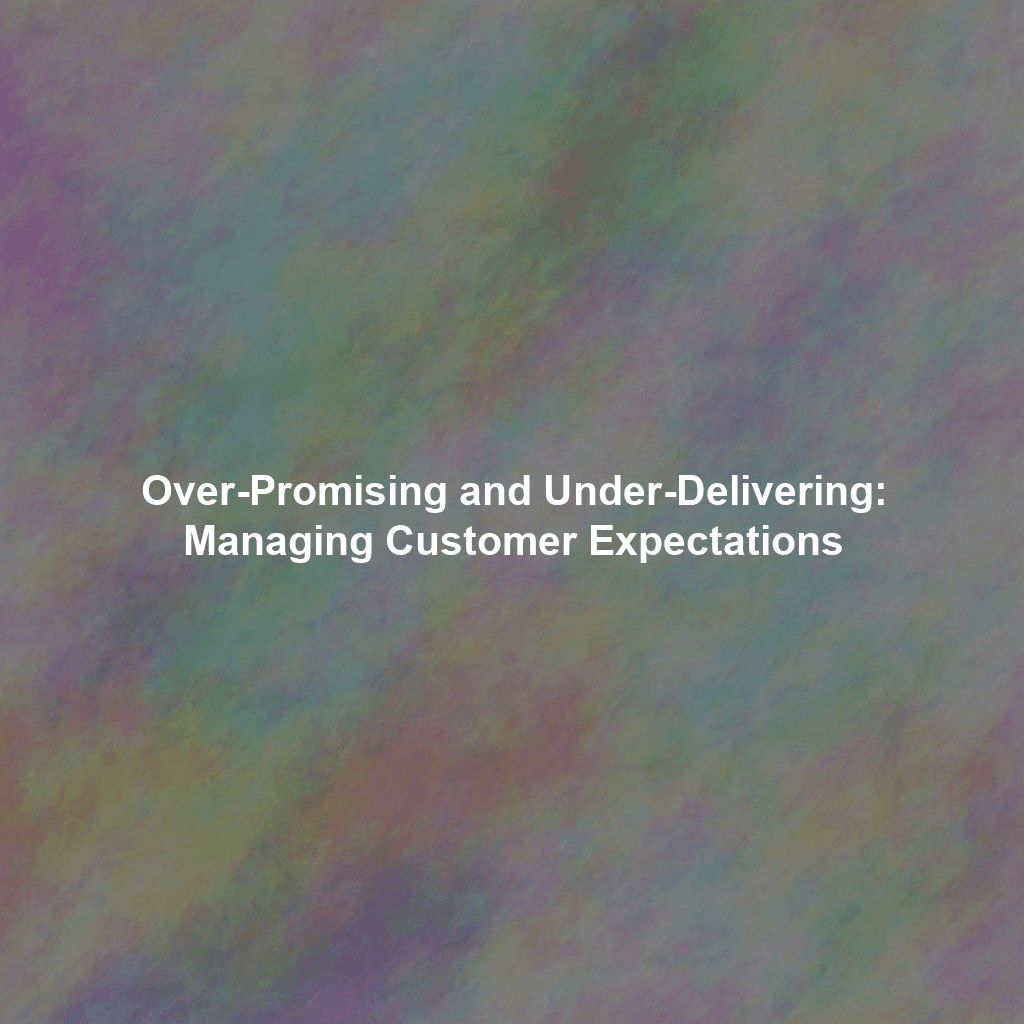We’ve all been there, haven’t we? Hooked by marketing that paints a picture so perfect it seems almost… well, *too* perfect. Weight loss plans promising lightning-fast results, software claiming to solve every business problem under the sun, deliveries guaranteed with an almost unsettling level of punctuality. These alluring promises, while tempting, often lead us down a path paved with good intentions, but riddled with potholes of disappointment.
The reality? Those stubborn pounds? They might just be *slightly* less cooperative than the ads suggest. That miracle software? It might have a *few*… let’s call them “quirks.” And the delivery? Let’s just say the delivery driver might have hit a *minor* snag or two. This gap, this chasm between what we’re *told* to expect and what actually happens, breeds disappointment. And in the business world, disappointment isn’t just a feeling; it’s a force, a potent one, capable of crippling even the most robust organizations.
Why the Over-Promise? A Peek Behind the Curtain
So, why do companies, sometimes seemingly against their own best interests, fall into this trap of over-promising? It’s a complex issue, with several contributing factors:
- The Siren Song of Standing Out: The marketplace is a crowded arena. To be heard, some companies resort to shouting, exaggerating their claims to cut through the noise. It’s a risky strategy, fueled by the fear of being overlooked, but it can backfire spectacularly.
- Short-Term Gains, Long-Term Pain: The allure of immediate sales can be intoxicating. Some companies, blinded by the prospect of quick profits, sacrifice long-term customer trust for a short-term boost. They fail to see the forest for the trees, ignoring the potential brand damage they’re inflicting.
- The Perils of Misunderstanding: Sometimes, the marketing team isn’t entirely on the same page as, say, the product development team. They might lack a deep understanding of the product’s *actual* capabilities or the customer’s *real* challenges. This can lead to promises based more on wishful thinking than concrete reality.
- The Competitive Hyperbole Hustle: When a competitor makes a bold claim, the pressure to “keep up” can be intense. This can trigger a dangerous race to hyperbole, where companies stretch the truth further and further, like an elastic band about to snap.
The Crushing Weight of Under-Delivery: The Consequences Are Real
Failing to meet customer expectations isn’t just a minor inconvenience; it has serious, far-reaching consequences:
- Erosion of Trust: Broken promises shatter trust. It’s the bedrock of any successful business relationship. Betrayed customers are unlikely to offer a second chance.
- The Wrath of Negative Word-of-Mouth: Disgruntled customers are vocal. They readily share their negative experiences, both online and offline, damaging your brand’s reputation and deterring potential customers. Think of it as a digital wildfire.
- The Customer Churn Carousel: Disappointed customers don’t stick around. They jump ship to competitors who offer more reliable products or, crucially, more *honest* capabilities.
- Brand Reputation: Tarnished: A pattern of over-promising brands you as untrustworthy. This makes it significantly harder to acquire new customers and, crucially, retain the ones you already have.
- The High Cost of Lost Customers: Acquiring new customers is significantly more expensive than keeping the ones you have. Losing customers due to unmet expectations necessitates higher marketing spending, creating a vicious cycle.
The Art of Expectation Management: A Path to Customer Delight (and Sanity)
The key to avoiding the over-promise trap lies in effective expectation management: setting realistic expectations from the outset and then consistently meeting, or even exceeding, them. It’s about under-promising and over-delivering. It’s about building trust, not eroding it.
Honest and Transparent Marketing: The Foundation of Trust
Honesty isn’t just a nice-to-have; it’s the *foundation*. Avoid hyperbole like the plague. Focus on the genuine benefits of your product or service and be upfront about any limitations. Use clear, concise language, avoiding jargon or misleading terms. Be completely transparent about pricing, terms, and conditions. Think of it as building a relationship based on mutual respect.
Know Your Customer: Empathy is Key
Understanding your target audience – their needs, their expectations, their pain points – is absolutely crucial. Tailor your marketing messages to their specific concerns and avoid making irrelevant or unrealistic promises. Conduct thorough market research. Align your product or service with their *actual* expectations, not what you *hope* they’ll be.
Under-Promise and Over-Deliver: The Classic Strategy
This is a time-tested strategy for a reason. Set expectations slightly lower than your realistic capabilities. This creates opportunities for pleasant surprises, which, let’s face it, everyone loves. For example, if a project realistically takes three weeks, quote four. Then, deliver in three. Boom. Instant customer satisfaction.
Communicate Effectively: Keep the Conversation Flowing
Keep your customers informed throughout the buying process with regular updates. Respond promptly to their questions and concerns. Proactive communication manages expectations and prevents misunderstandings before they even arise. Be transparent about any delays or challenges and clearly explain the steps you’re taking to resolve them.
Gather Feedback and Learn: Continuous Improvement is Essential
Actively solicit customer feedback to identify areas where you’re succeeding and, more importantly, areas where you need to improve. Use this feedback to refine your marketing messages, improve your product or service, and enhance the overall customer experience. Continuous improvement ensures you consistently meet and, ideally, exceed expectations.
Empower Your Employees: They’re on the Front Lines
Your front-line employees are the face of your company. They’re key to customer interaction. Empower them to resolve issues and make customer-centric decisions. Provide them with the necessary training and resources to effectively manage expectations and deliver exceptional service. They’re your brand ambassadors; treat them accordingly.
Manage Expectations in Sales: The Sales Process is Critical
The sales process is where expectations are often set (or, unfortunately, *mis-set*). Train your sales team to provide accurate information and actively discourage them from making unrealistic promises. Encourage a consultative approach, one focused on understanding and addressing the customer’s *real* challenges. This is far more effective than hard-selling based on exaggeration.
Document Everything: Leave No Room for Misinterpretation
Keep accurate records of *all* promises, whether written or verbal. This prevents misunderstandings and ensures everyone is on the same page. Use a CRM system to track interactions and record agreements. Clarity is key.
Beyond Satisfaction: Cultivating Customer Loyalty (The Holy Grail)
Managing expectations isn’t just about avoiding negativity; it’s about creating positive experiences that build genuine loyalty. Consistent delivery on realistic promises earns trust and respect. It turns customers into brand advocates, your most valuable asset.
Loyal customers are more likely to make repeat purchases, offer valuable recommendations, and, crucially, forgive occasional mistakes. They’re also less price-sensitive, making them a valuable and sustainable business asset.
The Bottom Line: Honesty is *Always* the Best Policy (Seriously)
The allure of exaggeration in marketing can be strong, but the long-term consequences of over-promising can be devastating. Embracing honesty, transparency, and a commitment to exceeding *realistic* expectations builds a strong brand, fosters loyalty, and achieves sustainable success. Remember, a happy customer isn’t just a satisfied customer; they are, quite literally, your most effective marketing tool.
 Skip to content
Skip to content

